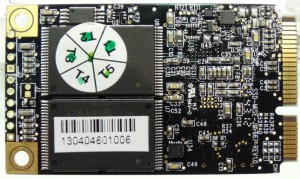We spoke to the new DEVSLP SATA specification a bit earlier this week and we are seeing a few manufacturers already preparing for its implementation. DEVSLP is only possible with SSDs and enables your system to continuously update, all the while preserving battery life while it is in an ultra low power sleep mode. As much as many might think this is the future, an excellent and parallel example of what occurs with is seen in our smart phones of today; continues updating, almost instance resuming of operation and no need to ever turn them on or off.

 While the DEVSLP specification demands that systems reach a sleep mode power rating of .05W, the M5301 uses much less power reaching a rating of .003W in sleep mode, this compared to .3W idle and 1.4W active use. The M5301 is available in capacities of 24, 36, 64 and 128GB and performance is listed at 521MB/s read and 286MB/s write transfer speeds.
While the DEVSLP specification demands that systems reach a sleep mode power rating of .05W, the M5301 uses much less power reaching a rating of .003W in sleep mode, this compared to .3W idle and 1.4W active use. The M5301 is available in capacities of 24, 36, 64 and 128GB and performance is listed at 521MB/s read and 286MB/s write transfer speeds.
BIWIN also had their new NGFF designs display on, powered by a Silicon Motion controller, and this is the first time we have seen this controller used in a SSD. Two Silicon Motion SSD controllers were announced last fall which consist of the SATA 2 SM2244LT, which speaks to a very small form factor, as well as the SATA 3 SM2246. Noth controllers are AES 128/256-bit compatible and TCG Opal compliant. The NGFF SSDs on display contained the SATA 2 SM2244LT capable of up to 280MB/s read and 165MB/s write and consisited of the G6200, G6201 and G5301.
Last but not least, BIWIN had a very interesting ‘active test bench’ that showed off the capabilities of LSI SandForce controllers in a power loss scenario. Using their ‘LSI SandForce Driven’ S8386 SATA 3 MLC SSD capable of 559MB/s read and 532MB/s write transfer speeds, their test system monitored data loss or SSD adnormal behaviour after sudden power loss. Although in the first day of the visit, the LSI SandForce solution had withstood 45 power loss simulations and remained intact.
 The SSD Review The Worlds Dedicated SSD Education and Review Resource |
The SSD Review The Worlds Dedicated SSD Education and Review Resource | 